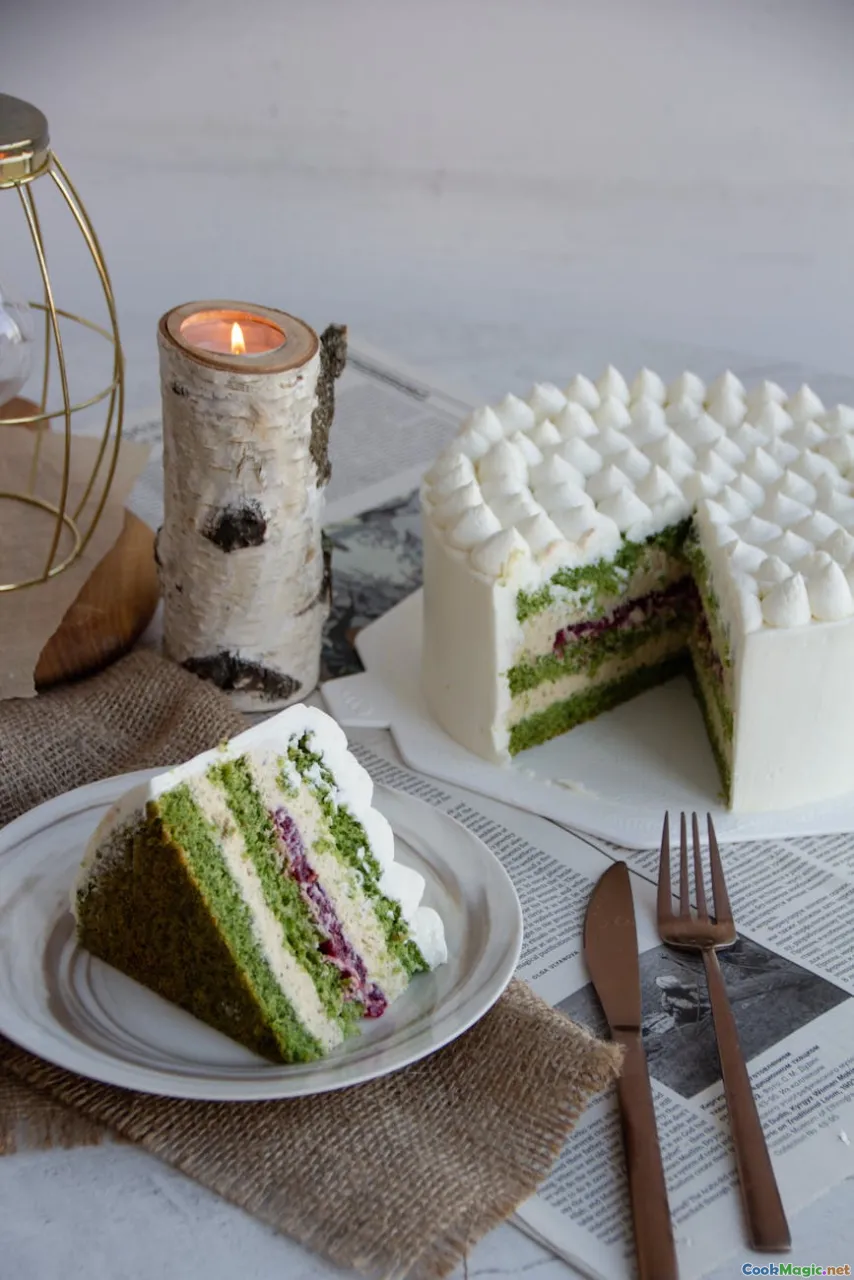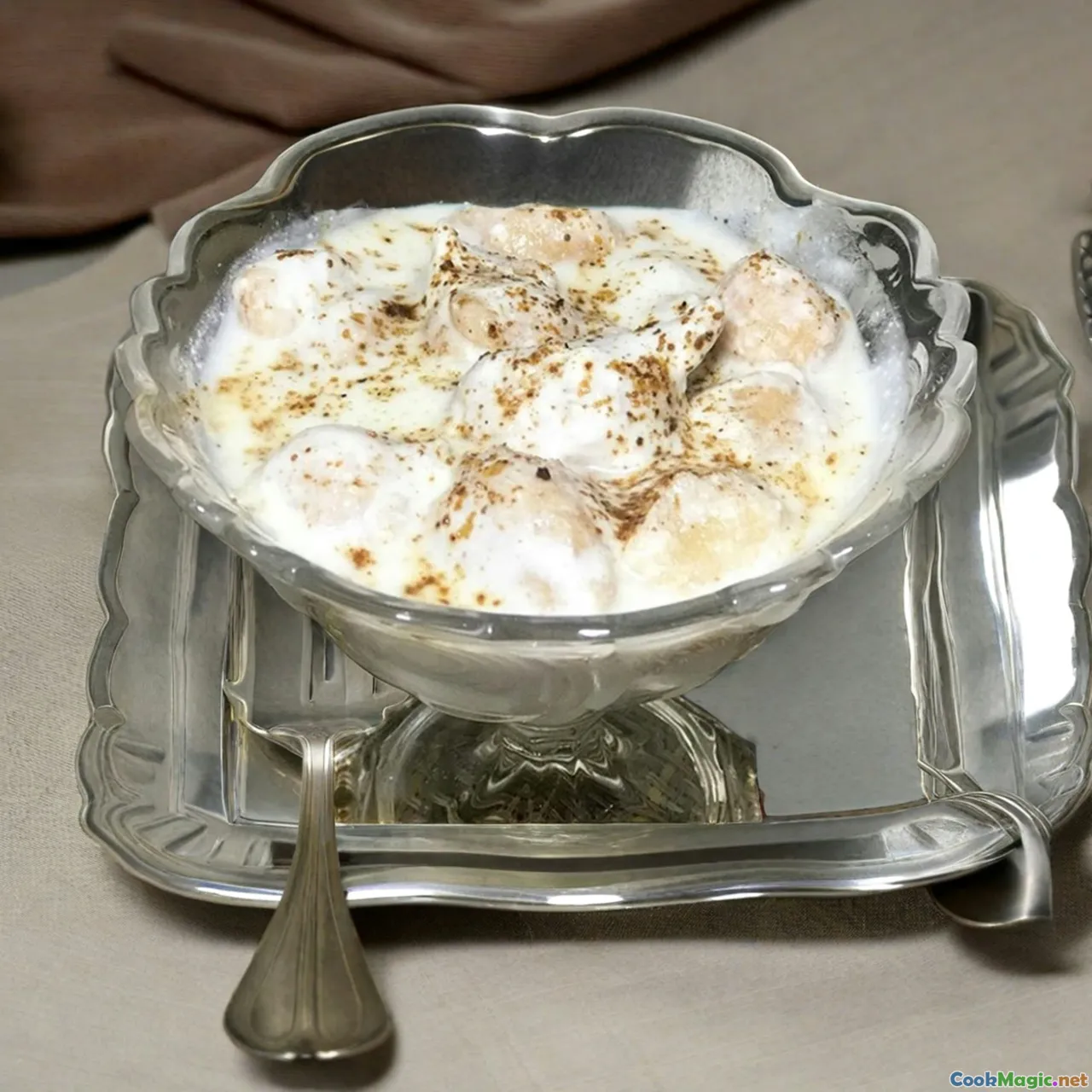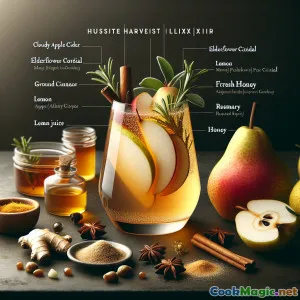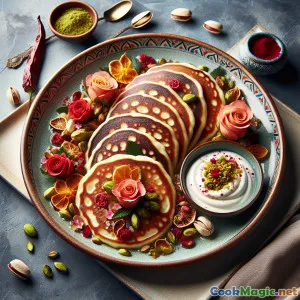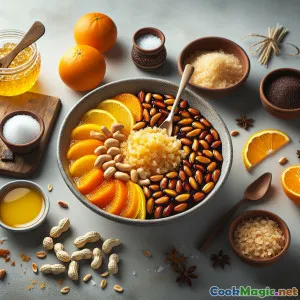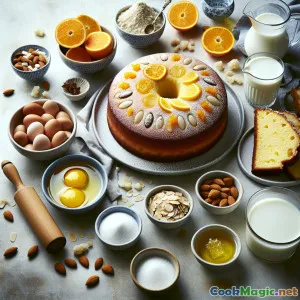
Huş Suyu & Arpa Kreması Kupaları: Bir İngiliz Lezzeti
(Birch Sap & Barley Cream Pots: An English Delight)
(0 Yorumlar)0
1,018
Temmuz 14, 2025
Bir Sorun Bildir
Malzemeler
-
60 grams İnce taneli arpa
(Soğuk suyla durulandı)
-
300 ml Tam süt
(Arpa pişirme)
-
200 ml Kızılcık özsuyu
(Taze veya şişelenmiş; daha hafif tatlı hindistan cevizi suyu ile değiştirilebilir)
-
250 ml İki kat krema
(Zenginlik ve pürüzsüz doku için)
-
60 grams Toz şeker
(Kama göre ayarlayın, huş ağacı özü şekerine bağlı olarak)
-
3 large Yumurta sarısı
(Oda sıcaklığında)
-
1 whole Vanilin Çubuğu
(Yarım ve çekirdekleri çıkarın veya 1 tatlı kaşığı vanilya macunu kullanın)
-
1/4 tsp Deniz tuzu
(Lezzeti artırır)
-
2 tsp Bal
(İngiliz yabani çiçekleri, serpmek için)
-
20 grams Kızarmış fındıklar
(Kaba doğranmış, süsleme için)
(Soğuk suyla durulandı)
(Arpa pişirme)
(Taze veya şişelenmiş; daha hafif tatlı hindistan cevizi suyu ile değiştirilebilir)
(Zenginlik ve pürüzsüz doku için)
(Kama göre ayarlayın, huş ağacı özü şekerine bağlı olarak)
(Oda sıcaklığında)
(Yarım ve çekirdekleri çıkarın veya 1 tatlı kaşığı vanilya macunu kullanın)
(Lezzeti artırır)
(İngiliz yabani çiçekleri, serpmek için)
(Kaba doğranmış, süsleme için)
Besin Değerleri
- Porsiyon: 4
- Porsiyon Boyutu: 1 ramekin (150ml)
- Calories: 350 kcal
- Carbohydrates: 33 g
- Protein: 7 g
- Fat: 21 g
- Fiber: 2.5 g
- Sugar: 13 g
- Sodium: 70 mg
- Cholesterol: 134 mg
- Calcium: 115 mg
- Iron: 1.2 mg
Talimatlar
-
1 - Sütle Arpa Pişirme:
İnce arpaşehriyesini yıkayın ve bütün sütle küçük bir tencerede ekleyin. Hafifçe kaynamaya bırakın ve kapağını açmadan pişirin, arpaşehriye çok yumuşayana kadar, yaklaşık 25 dakika. Yapışmasını önlemek için düzenli karıştırın. Bir kenara alın ve hafifçe soğumasını sağlayın.
-
2 - Kremamsı Doku İçin Karıştırma:
Pişmiş arpayı ve kalan sütü bir mutfak robotuna dökün. Karışım olabildiğince pürüzsüz olana kadar iyice karıştırın. Daha pürüzsüz bir doku için ince bir elekle süzün ve kalan arpa kabuğunu çıkarın.
-
3 - Meşe Suyu ve Kremayı Demlemek:
Temiz bir tencerede huş ağacı suyu, çift krema, süzülmüş arpa karışımı ve vanilin podunun tohumlarını (kullanıyorsanız) birleştirin. Nazikçe ısıtın, sürekli karıştırarak, buhar çıkmaya başlayana kadar ama kaynamayacak şekilde.
-
4 - Yumurta sarısı ve şeker hazırla:
Bu sırada, büyük bir kasede yumurta sarılarını pudra şekeri ve deniz tuzu ile çırpın, renkleri daha açık ve hafifçe kalınlaşana kadar.
-
5 - Baharatla ve Karıştır:
Sıcak huş odunu-arpalık kremasının yaklaşık üçte birini sürekli çırparak yumurta karışımına yavaşça dökün. Isıtan karışım hafifçe ısındığında, yumurta karışımını kalan sıcak sıvı ile birlikte tencereye tekrar çırpın.
-
6 - Krem Bazını Pişirme:
Küçük ateşte, karışımı sürekli çırparak kıvam almasını sağlayın; spatula kaplayacak kadar koyulaşana kadar (dijital termometre kullanıyorsanız yaklaşık 82°C). Kaynamasına izin vermeyin.
-
7 - Ramekinde Soğutun:
Dört adet 150ml'lik ramekinlere bölün. Oda sıcaklığına soğumasını sağlayın, sonra üzerini kapatıp en az 2 saat buzdolabında soğutun, hafifçe katılaşana kadar.
-
8 - Süsleme ve Servis:
Servis yaparken, üzerine biraz İngiliz balı gezdirin ve isteğe bağlı olarak kıyılmış kızarmış fındık serpin. Soğuk ve kremamsı olarak servis yapın.
İnce arpaşehriyesini yıkayın ve bütün sütle küçük bir tencerede ekleyin. Hafifçe kaynamaya bırakın ve kapağını açmadan pişirin, arpaşehriye çok yumuşayana kadar, yaklaşık 25 dakika. Yapışmasını önlemek için düzenli karıştırın. Bir kenara alın ve hafifçe soğumasını sağlayın.
Pişmiş arpayı ve kalan sütü bir mutfak robotuna dökün. Karışım olabildiğince pürüzsüz olana kadar iyice karıştırın. Daha pürüzsüz bir doku için ince bir elekle süzün ve kalan arpa kabuğunu çıkarın.
Temiz bir tencerede huş ağacı suyu, çift krema, süzülmüş arpa karışımı ve vanilin podunun tohumlarını (kullanıyorsanız) birleştirin. Nazikçe ısıtın, sürekli karıştırarak, buhar çıkmaya başlayana kadar ama kaynamayacak şekilde.
Bu sırada, büyük bir kasede yumurta sarılarını pudra şekeri ve deniz tuzu ile çırpın, renkleri daha açık ve hafifçe kalınlaşana kadar.
Sıcak huş odunu-arpalık kremasının yaklaşık üçte birini sürekli çırparak yumurta karışımına yavaşça dökün. Isıtan karışım hafifçe ısındığında, yumurta karışımını kalan sıcak sıvı ile birlikte tencereye tekrar çırpın.
Küçük ateşte, karışımı sürekli çırparak kıvam almasını sağlayın; spatula kaplayacak kadar koyulaşana kadar (dijital termometre kullanıyorsanız yaklaşık 82°C). Kaynamasına izin vermeyin.
Dört adet 150ml'lik ramekinlere bölün. Oda sıcaklığına soğumasını sağlayın, sonra üzerini kapatıp en az 2 saat buzdolabında soğutun, hafifçe katılaşana kadar.
Servis yaparken, üzerine biraz İngiliz balı gezdirin ve isteğe bağlı olarak kıyılmış kızarmış fındık serpin. Soğuk ve kremamsı olarak servis yapın.
Huş Suyu & Arpa Kreması Kupaları: Bir İngiliz Lezzeti :Hakkında Daha Fazlası
Birch Sap and Barley Cream Pots
Summary
This wholly original recipe for Birch Sap and Barley Cream Pots captures the gentle awakening of an English spring in a delicate, creamy dessert bowl. Combining the subtle, natural sweetness of birch sap with the nutty, old-world flavors of barley, and elevating it all with rich dairy and softly set custard, this dish blurs the lines between modern British innovation and age-old traditions. Its unassuming, creamy aesthetics hint at something more interesting upon first spoonful—an earthy complexity and layers of silky, gentle sweetness.
History and Cultural Significance
Birch sap, gathered from centuries-old woodland traditions, was once a celebrated ingredient in the Northern Hemisphere—tapped for just a few short weeks each spring. In the UK, though largely forgotten in mainstream cuisine, folklore remembers birch sap as a rejuvenating 'British tonic,' sometimes fermented into wine or mixed into healing concoctions. Barley’s role as a staple cereal can be traced from Neolithic times to roots in rustic British desserts and hearty stews, symbolizing resilience, comfort, and an affinity with the landscape.
Combining birch sap with barley in a creamy custard was inspired by traditional milk puddings and contemporary farmhouse desserts, but here given a new voice—bridging foraged, historic flavors and classic dessert typology.
Unique Aspects and Personal Notes
Birch Sap and Barley Cream Pots stand out not just for their writeup of “wild sophistication:”
-
The birch sap brings unique complexity, lightly floral, slightly sweet, unlike anything sugar or syrup could impart. Using birch sap as a base (where you might otherwise reach for milk, water, or coconut water) coaxes out woodsy, sappy nuances and gently perfumes the dessert.
-
Barley lends nutty undertones and provides a textural base for the custard when rendered ultra-smooth. It bulks the cream without heaviness, forming the bridge between tradition and elegance.
-
The slow, low cook and careful tempering of egg yolks ensure an unctuous, gentle set—not quite a thick jelly, more opulent than most milk puddings, yet firmer than classic pouring custard.
-
Lightly sweetened, with a dash of honey to serve, it needs little embellishment: a contrast of roughly chopped hazelnuts highlights the woodland origins and counters the creaminess, while a use of vanilla is purely optional—leaning into (or away from) the pure birch-milk aroma as you wish.
Tips & Notes
- Sourcing birch sap can be the main barrier; look for it bottled online or at specialty food stores during spring. If unavailable, slightly diluted maple water or even coconut water makes a gentle and neutral substitute, though each lacks pure birch nuance.
- The barley cream achieves true silkiness by thorough blending and straining—don’t rush this part.
- If desired, infuse other seasonal wild herbs (like meadowsweet or elderflower) into the cream just before straining, amplifying the wild character of the dessert.
- Keeping the yolk-cream mixture below boiling (82°C/180°F) prevents curdling, giving that opulent texture prized in classic pots de crème.
- These set softly for an impressive table finish but keep hands-off when cooling; the chilling step is essential to their success.
Variations and Serving
You may experiment with nut toppings—try toasted pecans or almonds. Birch syrup (used with restraint) works as a garnish for darker caramel bitterness, or swap in seasonal berries and a little buttermilk for a tart contrast. Best served foraged-ingredient dinners, a woodland afternoon tea, or simply to evoke lush English meadows wherever you are. If serving to guests, the story of birch sap’s scarcity and tradition could become the star conversation.
This unique dessert pot manages to be both subtly wild and beautifully refined—an unmistakable taste of the British landscape, reimagined for today’s palate.

